Renault Clio: Plugs: Removal - Refitting
D4F, and 740 - D4F, and 784 or 786
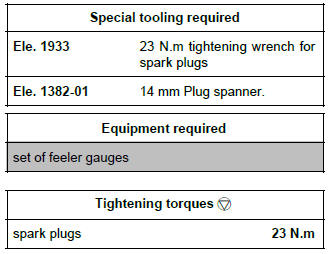
Spark plug electrode gap

REMOVAL
I - REMOVAL PREPARATION OPERATION
D4F, and 784
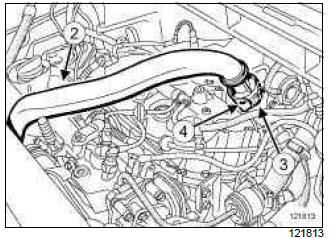
- Remove the turbocharger air outlet pipe bolt (2) from the inlet distributor.
- Remove the turbocharger air outlet pipe clip (3) from the turbocharger.
Note: If the clip (4) is removed from the heat resistant protector, the latter must be replaced.
- Move aside the turbocharger air outlet pipe.
D4F, and 740
- Remove the air filter unit (see 12A, Fuel mixture, Air filter unit: Removal - Refitting, 12A-17).
II - OPERATION FOR REMOVAL OF PART CONCERNED
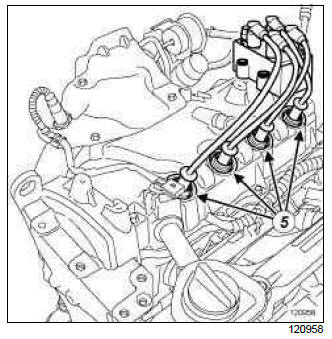
WARNING
To disconnect the spark plug leads, pull on the extensions and not on the leads.
- Disconnect the spark plug ignition wiring harnesses (5).
- Remove the spark plugs using the (Ele. 1933) equipped with the (Ele. 1382-01).
REFITTING
I - REFITTING PREPARATION OPERATION
- Check and, if necessary, correct the spark plug electrode gaps using a set of feeler gauges.
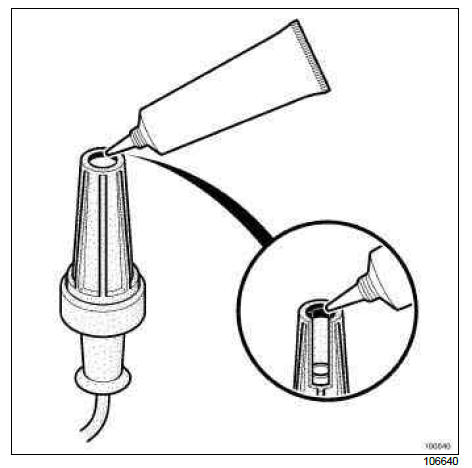
- It is essential to apply a bead of FLUOSTAR 2L (see Vehicle: Parts and consumables for the repair) (04B, Consumables - Products) with a diameter of 2 mm to the inner edge of the high tension caps on the spark plug and ignition coil side.
II - REFITTING OPERATION FOR PART CONCERNED
- Refit the spark plugs.
- Torque tighten the spark plugs (23 N.m) using the (Ele. 1933) fitted with the (Ele. 1382-01).
III - FINAL OPERATION
- Connect the ignition wiring harnesses to the spark plugs.
D4F, and 784
- Refit the turbocharger air outlet pipe.
- Clip the turbocharger air outlet pipe onto the turbocharger.
- Refit the turbocharger air outlet pipe bolt on the inlet distributor.
D4F, and 740
- Refit the air filter unit (see 12A, Fuel mixture, Air filter unit: Removal - Refitting, 12A-17).
F4R
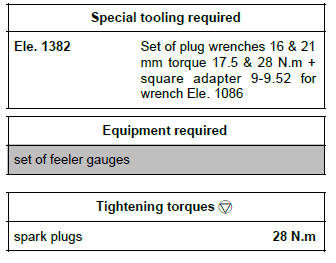
Spark plug electrode gap

REMOVAL
I - REMOVAL PREPARATION OPERATION
- Remove:
- the engine cover (if fitted),
- the ignition coils (see 17A, Ignition, Coils: Removal - Refitting, 17A-2).
II - OPERATION FOR REMOVAL OF PART CONCERNED
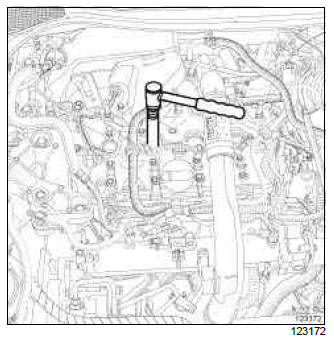
- Remove the spark plugs using the tool (Ele. 1382) with the grey sleeve.
REFITTING
I - REFITTING PREPARATION OPERATION
- Check and, if necessary, correct the spark plug electrode gaps using a set of feeler gauges.
II - REFITTING OPERATION FOR PART CONCERNED
- Refit the spark plugs.
- Torque tighten the spark plugs (28 N.m) using (Ele.1382) fitted with the grey sleeve.
III - FINAL OPERATION
- Refit:
- the ignition coils (see 17A, Ignition, Coils: Removal - Refitting, 17A-2),
- the engine cover (if fitted).
M4R
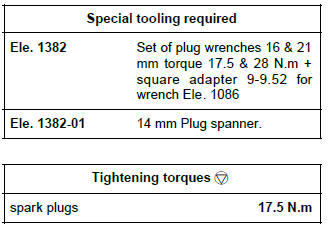
REMOVAL
I - REMOVAL PREPARATION OPERATION
- Remove:
- the engine cover,
- the inlet manifold (see 12A, Fuel mixture, Inlet distributor: Removal - Refitting, 12A-45),
- the ignition coils (see 17A, Ignition, Coils: Removal - Refitting, 17A-2).
II - OPERATION FOR REMOVAL OF PART CONCERNED
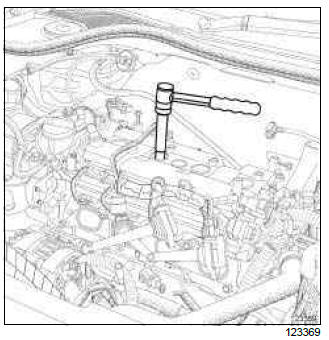
- Remove the spark plugs using the tool (Ele. 1382) with the red sleeve equipped with the tool (Ele.1382-01).
REFITTING
I - REFITTING OPERATION FOR PART CONCERNED
- Refit the spark plugs.
- Torque tighten the spark plugs (17.5 N.m) using the tool (Ele. 1382) with the red sleeve equipped with the tool (Ele. 1382-01).
II - FINAL OPERATION
- Refit:
- the ignition coils (see 17A, Ignition, Coils: Removal - Refitting, 17A-2),
- the inlet manifold (see 12A, Fuel mixture, Inlet distributor: Removal - Refitting, 12A-45),
- the engine cover.
K4J or K4M
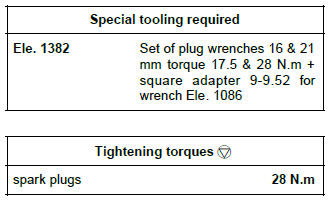
Spark plug electrode gap
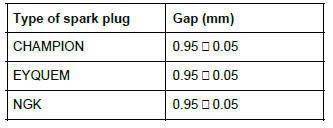
REMOVAL
I - REMOVAL PREPARATION OPERATION
- Remove the ignition coils (see 17A, Ignition, Coils: Removal - Refitting, 17A-2).
II - OPERATION FOR REMOVAL OF PART CONCERNED
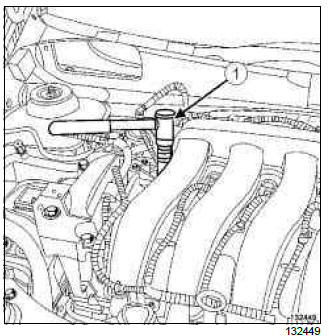
- Remove the spark plugs using (Ele. 1382) (1).
REFITTING
I - REFITTING PREPARATION OPERATION
- Check and, if necessary, correct the electrode gap for each spark plug.
II - REFITTING OPERATION FOR PART CONCERNED
- Refit the spark plugs.
- Torque tighten the spark plugs (28 N.m) using (Ele.1382) fitted with the grey sleeve.
III - FINAL OPERATION
- Refit the ignition coils (see 17A, Ignition, Coils: Removal - Refitting, 17A-2).
D4F, and 740 - D4F, and 742 or 764
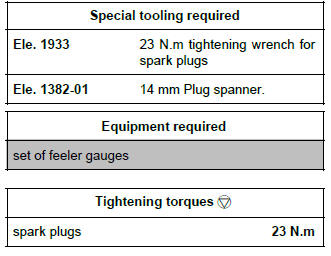
Spark plug electrode gap

REMOVAL
I - REMOVAL PREPARATION OPERATION
D4F, and 740 - D4F, and 742 or 764
- Remove the air filter unit (see 12A, Fuel mixture, Air filter unit: Removal - Refitting, 12A-17).
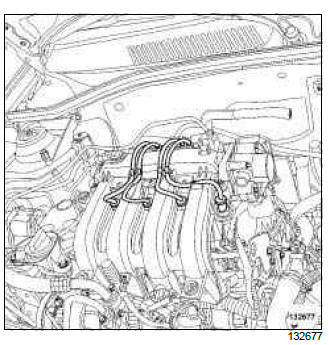
WARNING
To disconnect the spark plug leads, pull on the extensions and not on the leads.
- Disconnect the spark plug wiring.
II - OPERATION FOR REMOVAL OF PART CONCERNED
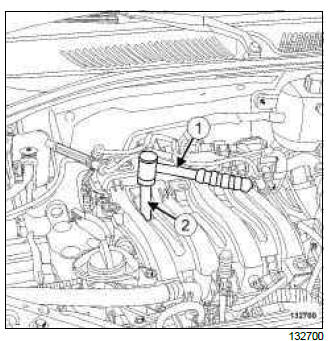
- Remove the spark plugs using the (Ele. 1933) (1) equipped with the (Ele. 1382-01) (2).
REFITTING
I - REMOVAL PREPARATION OPERATION
- Check and, if necessary, correct the spark plug electrode gaps using a set of feeler gauges.
II - REFITTING OPERATION FOR PART CONCERNED
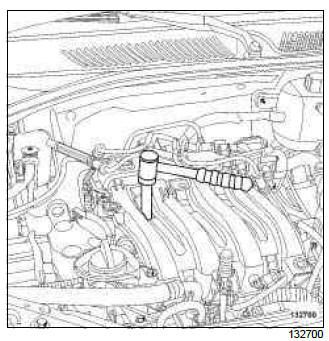
- Refit the spark plugs.
- Torque tighten the spark plugs (23 N.m) using the (Ele. 1933) fitted with the (Ele. 1382-01).
III - FINAL OPERATION
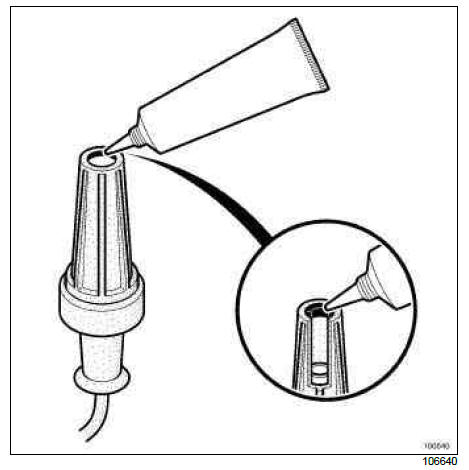
- Apply a bead of FLUORSTAR 2L grease (see Vehicle: Parts and consumables for the repair) (04B, Consumables - Products) 2 mm in diameter on the internal perimeter of the high-tension caps at the spark plug end.
- Connect the spark plug wiring.
D4F, and 740 - D4F, and 742 or 764
- Refit the air filter unit (see 12A, Fuel mixture, Air filter unit: Removal - Refitting, 12A-17).

